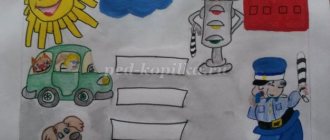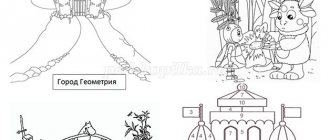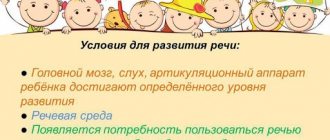Direction “Artistic and aesthetic development”. Preparatory group for school (from 6 to 7 years old)
Educational field "Artistic creativity"
The content of the educational field “Artistic Creativity” is aimed at achieving the goals of developing interest in the aesthetic side of the surrounding reality, satisfying children’s need for self-expression through solving the following tasks:
- development of children's productive activities (drawing, modeling, appliqué, artistic work);
- development of children's creativity;
- introduction to the fine arts.
Development of productive activities
| Drawing | Subject drawing. Improve the ability to depict objects from memory and from life. Develop observation skills, the ability to notice the characteristic features of objects and convey them through drawing (shape, proportions, location on a sheet of paper). Improve your imaging technique. Continue to develop freedom and at the same time accuracy of hand movements under visual control, their smoothness and rhythm. Expand the range of materials that children can use in drawing (gouache, watercolor, dry and oily pastels, sanguine, charcoal pencil, gel pen, etc.). Offer to combine different materials in one drawing to create an expressive image. Direct children's attention to new ways of working with already familiar materials (for example, painting with watercolors on a damp layer); different ways of creating a background for the picture being depicted: when painting with watercolors and gouache - to creating an angry image; When drawing with pastels and colored pencils, the background can be prepared either at the beginning or after completing the main image. Continue to develop the ability to freely use a pencil when performing a linear drawing, practice smooth turns of the hand when drawing rounded lines, curls in different directions (from a branch and from the end of a curl to a branch, vertically and horizontally), learn to move the whole hand when drawing long lines, large shapes, with just your fingers - when drawing small shapes and small details, short lines, strokes, grass (Khokhloma), animation (Gorodets), etc. Develop the ability to see the beauty of the created image and in conveying the form, smoothness, unity of lines or their subtlety, elegance, rhythmic arrangement of lines and spots, uniform shading of the pattern; feel the smooth transitions of color shades resulting from uniform painting and adjusting the pressure on the pencil. Develop an understanding of the variety of colors and shades, based on the real coloring of objects, decorative painting, and fairy-tale scenes; learn to create colors and shades. Gradually lead children to the designation of colors that include two shades (yellow-green, gray-blue) or similar to natural ones (raspberry, peach, etc.). Draw their attention to the variability of the color of objects (for example, tomatoes are green during growth, but ripe ones are red). Learn to notice color changes in nature due to weather changes (the sky is blue on a sunny day and gray on a cloudy day), develop color perception in order to enrich the color scheme of the picture. Strengthen children’s ability to distinguish shades of colors and convey them in drawings; develop perception, the ability to observe and compare the colors of surrounding objects and phenomena (delicate green leaves that have just appeared, pale green stems of dandelions and their dark green leaves, etc.). Subject drawing. Improve children's ability to place images on a sheet of paper in accordance with their real location (closer or further from the person drawing; closer to the bottom edge of the sheet - foreground or further from it - background); convey differences in the size of the depicted objects (a tall tree, a flower below the tree; a small sparrow, a large crow, etc.). To develop the ability to build a composition of a drawing; convey the movements of people and animals, plants bending in the wind. Continue to develop the ability to convey in drawings both the plots of folk tales and original works (poems, fairy tales, stories); show independence in choosing a theme, composition and color scheme. Decorative drawing. Continue to develop children's decorative creativity; the ability to create patterns based on folk paintings, already familiar to children and new ones (Gorodets, Gzhel, Khokhloma, Zhostovo, Mezen painting, etc.). To develop the ability to highlight and convey the color scheme of folk decorative art of a certain type. Strengthen the ability to create compositions on sheets of paper of different shapes, silhouettes of objects and toys; paint toys made by children. To consolidate the ability to use characteristic pattern elements and colors when composing a decorative composition based on a particular type of folk art. |
| Modeling | Develop children's creativity. To develop the ability to freely use various techniques previously learned to create images of objects, natural objects, and fairy-tale characters; convey the shape of the main part and other parts, their proportions, pose, characteristic features of the depicted objects; process the surface of the mold using finger movements and a stick. Continue to develop the ability to convey the characteristic movements of humans and animals, to create expressive images (a bird raised its wings, prepared to fly; a goat is jumping, a girl is dancing; children are doing gymnastics - a collective composition). Develop the ability to create sculptural groups of two or three figures, develop a sense of composition, the ability to convey the proportions of objects, their ratio in size, expressiveness of poses, movements, and details. Decorative modeling. Continue to develop decorative modeling skills; learn to use different methods of sculpting (patterning, in-depth relief), and use stacking. When sculpting from clay, learn how to paint a plate and create a pattern in stacks; create subject and subject, individual and collective compositions from clay and multi-colored plasticine. |
| Application | Improve the ability to create subject and subject images from nature and from imagination: develop a sense of composition (learn to beautifully arrange figures on a sheet of paper in a format corresponding to the proportions of the objects depicted). Develop the ability to create patterns and decorative compositions from geometric and plant elements on sheets of paper of various shapes; depict birds and animals according to one’s own design and based on folk art. Reinforce techniques for cutting out symmetrical objects from paper folded in half; several objects or parts thereof made of paper folded like an accordion. When creating images, encourage the use of various techniques of cutting out, tearing paper, gluing images (smearing them with glue completely or partially, creating the illusion of conveying volume); teach the mosaic method of depicting with a preliminary light indication with a pencil of the shape of the parts and details of the picture. Continue to develop a sense of color, flavor, composition. Encourage creativity. |
Development of children's creativity
To form in children a sustainable interest in visual arts. Enrich sensory experience, include hand movements on the object in the process of familiarization with objects.
Continue to develop figurative aesthetic perception, figurative ideas, form aesthetic judgments; learn to evaluate their own work and the work of their peers in a reasoned and detailed manner, paying attention to the obligation of a friendly and respectful attitude towards the work of their comrades.
To form an aesthetic attitude towards objects and phenomena of the surrounding world, works of art, and artistic and creative activities.
Foster independence; develop the ability to actively and creatively apply previously learned methods of representation in drawing, modeling and appliqué, using expressive means.
Improve the ability to draw from life; develop analytical skills, the ability to compare objects with each other, highlight the features of each object. Improve the ability to depict objects, conveying their shape, size, structure, proportions, color, composition.
Continue to develop collective creativity. Cultivate a desire to act in concert, to agree on who will do what part of the work, how individual images will be combined into the overall picture.
Develop the ability to notice the shortcomings of your work and correct them: make additions to achieve greater expressiveness of the created image.
Introduction to fine arts
To form the foundations of artistic culture. Continue to develop an interest in art. To consolidate knowledge about art as a form of creative activity of people, about types of art (decorative and applied arts, fine arts, literature, music, architecture, theater, dance, cinema, circus).
Expand children's knowledge about fine arts, develop artistic perception of works of fine art. Continue to introduce children to works of art; I. Shishkin (“Rye”, “Morning in a Pine Forest”), I. Levitan (“Golden Autumn”, “March” “Spring. Big Water”), A. Savrasov (“The Rooks Have Arrived”), A. Plastov ( “Noon”, “Summer”, “Haymaking”), V. Vasnetsov (“Alyonushka”, “Bogatyrs”. “Ivan Tsarevich on the Gray Wolf”), etc.
Expand the understanding of sculpture of small forms, highlighting figurative means of expression (shape, proportions, color, characteristic details, pose, movements, etc.).
Expand ideas about artists - children's book illustrators (I. Bilibin, Yu. Vasnetsov, V. Konashevich, V. Lebedev, T. Mavrika, E. Charushin, etc.).
Continue to introduce children to folk arts and crafts (Gzhel, Khokhloma, Zhostovo, Mezen painting), ceramics, and folk toys.
Continue to introduce architecture, consolidate and enrich children’s knowledge that there are buildings for various purposes (residential buildings, shops, cinemas, kindergartens, schools, etc.).
Develop the ability to highlight the similarities and differences of architectural structures of the same purpose. Learn to identify identical parts of a structure and features of parts.
Introduce the specifics of temple architecture: dome, arches, arcature belt around the perimeter of the building, drum (the round part under the dome), etc. Introduce architecture based on the regional characteristics of the area in which they live. Tell the children that, as in every form of art, there are monuments in architecture that are known all over the world: in Russia these are the Kremlin, St. Basil's Cathedral, the Winter Palace, St. Isaac's Cathedral, Peterhof, monuments of the "Golden Ring" and others - in different their cities.
Develop the ability to convey images of architectural structures and fairy-tale buildings in artistic activities. Encourage the desire to depict the details of buildings (platbands, carved valance along the contour of the roof).
Expand children’s knowledge about creative activity and its features; learn to name the types of artistic activity, the profession of an artist (painter, composer, entertainer, dancer, singer, pianist, violinist, director, theater director, architect, etc.).
Develop aesthetic feelings, emotions, experiences; learn to independently create artistic images in different types of activities.
Explain to children the importance of human senses for artistic performance, teach them to correlate senses with types of art (they listen to music, look at paintings, read and listen to poetry, etc.).
Introduce children to history and art forms; teach to distinguish between folk and professional art. Organize a visit to an exhibition, theater, museum, circus (together with parents).
Develop a positive attitude towards art.
Expand ideas about the diversity of folk art and crafts (different types of materials, different regions of the country and the world). Cultivate interest in the art of your native land; instill love and respect for works of art.
Encourage children to actively participate in artistic activities of their own free will and under the guidance of an adult.
Aesthetic development environment. Continue to expand children's understanding of the environment (design of premises, kindergarten area, park, public garden).
Develop a desire to admire the beauty of environmental objects: handicrafts, nature, architectural structures.
Teach children to highlight components of the environment that are pleasing to the eye (wall painting, furniture, site design, etc.).
Involve children in designing exhibitions in a group, kindergarten, organizing play corners, arranging materials for independent creative activities, etc.
To develop in children the ability to aesthetically evaluate the environment, express value judgments, and justify their opinions.
Educational field "Music"
The content of the educational field “Music” is aimed at achieving the goal of developing children’s musicality and the ability to emotionally perceive music through solving the following tasks:
- development of musical and artistic activities;
- introduction to the art of music.
Musical and artistic activities, introduction to musical art
| Hearing | Continue to introduce children to musical culture and cultivate artistic and aesthetic taste. Enrich children's musical experiences, evoke a vivid emotional response when perceiving music of a different nature. Introduce basic musical concepts: musical image, means of expression, musical genres (ballet, opera); professions (pianist, conductor, composer, singer, ballerina and ballerina, artist, etc.). Continue to develop the skills of perceiving sounds in pitch within the fifth-third. Enrich children's impressions, form musical taste, develop musical memory. Promote the development of thinking, imagination, memory, hearing. Introduce basic musical concepts (tempo, rhythm); genres (opera, concert, symphony concert), the work of composers and musicians. Introduce children to the melody of the National Anthem of the Russian Federation. Singing Improve your singing voice and vocal-auditory coordination. To consolidate practical skills in the expressive performance of songs ranging from C of the first octave to D of the second octave. Learn to take your breath and hold it until the end of the phrase; pay attention to articulation (diction), consolidate the ability to sing independently, individually and collectively, with and without musical accompaniment. |
| Song creativity | Develop the ability to independently come up with melodies, using Russian folk songs as a model; independently improvise melodies on a given topic with or without a model, using familiar songs, musical pieces and dances. |
| Musical and rhythmic movements | To promote the further development of dance movement skills, the ability to move expressively and rhythmically in accordance with the diverse nature of the music, conveying emotional and figurative content in dance. Introduce national dances (Russian, Belarusian, Ukrainian, etc.). Develop dance and play creativity; to develop skills in the artistic performance of various images when staging songs and theatrical performances. |
| Musical, gaming and dance creativity | To promote the development of children's creative activity in accessible types of musical performing activities (playing in an orchestra, singing, dance movements, etc.). Improve the ability to improvise to music of a corresponding nature (skier, skater, horseman, fisherman; crafty cat; angry goat, etc.). Strengthen the ability to come up with movements that reflect the content of the song; act expressively with imaginary objects. Develop independence in finding a way to convey musical images in movements. Develop musical abilities; promote the manifestation of activity and independence. |
| Playing children's musical instruments | Introduce musical works performed by various instruments and in orchestral arrangements. Improve skills in playing metallophones, pipes, percussion and electronic musical instruments, Russian folk musical instruments: rattles, rattles, triangles; ability to perform musical works in an orchestra in an ensemble. |


